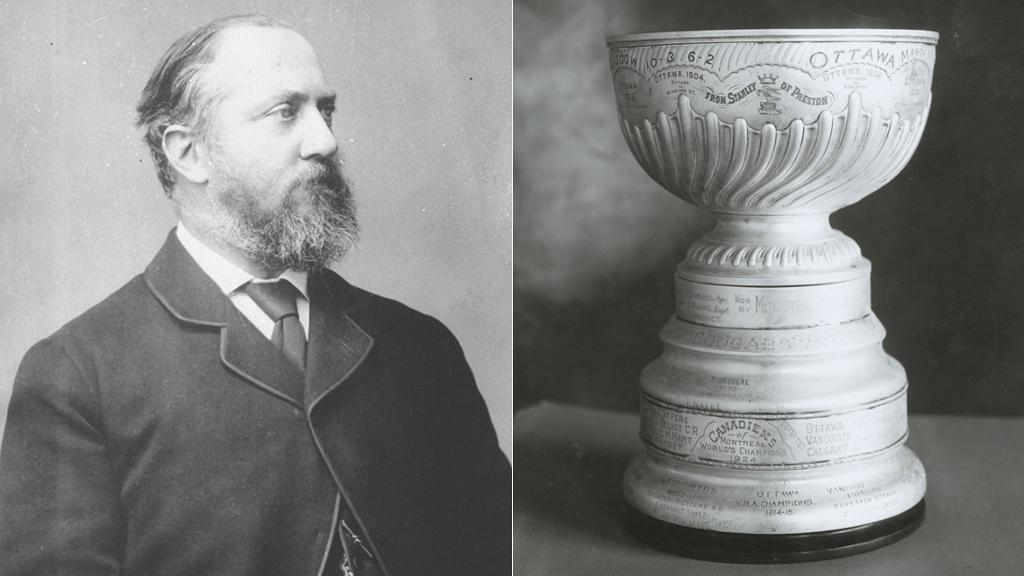He Scores!(1893)
Hockey players covet their sport’s Stanley Cup, North America’s oldest and most colorful trophy. While fans keep their eyes on the prize, many draw a blank when it comes to its originator: Frederick Arthur Stanley, (Lord Stanley of Preston.)
Born in 1841 in London, Frederick was the son of the Earl of Derby, a three-time prime minister. He took the upper crust path of education at Eton, followed by positions of Conservative member of parliament, and lord of the admiralty. The aristocrat would have been a forgotten footnote of history had Queen Victoria not appointed him governor general of Canada. An 1888 New York Times made Lord Stanley second fiddle to the Marquis of Lansdowne who was departing Canada for India.
The blueblood, along with his wife, Lady Constance, and their children-they had ten-political popularity waned as he proved a lackluster leader. A reporter wrote, Lord Stanley “willingly consented to speak, but said he had nothing to tell.” What excited Frederick most about his adopted homeland was hockey. He had become a fan after watching the Montreal Hockey Club during the city’s 1889 Winter Carnival. His sons, Arthur and Algernon, were avid participants who started the Ottawa Rideau Hall Rebels. The National Women’s Hockey League championship trophy, the Isobel Cup, took its name from his daughter.
On a trip to London, Frederick paid ten guineas, (in today’s currency, $1,000,) for a silver punch-sized bowl that would be “presented to the champion hockey team in the Dominion of Canada.” He christened his award: the Dominion Hockey Challenge Cup; it eventually took the name of the governor-general. The first recipient of the Stanly Cup was the Montreal Hockey Club, (the team associated with the Montreal Amateur Athletic Association.) Frederick was not present for the occasion as he had returned to England upon the death of his older brother, whereby he became the 16th Earl of Derby.
A Stanley Cup holds the engraved names of the current year’s winning players, a tradition that began as some of the athletes had already done so themselves. By 1963, due to wear and tear on the trophy, officials retired the original that now resides in the Vault Room at the Hockey Hall of Fame in Toronto. The Cup shares space with Lord Stanley; the hockey association inducted their “Honoured Biolder” into the Hall in 1945. Frederick passed away in 1908; his obituary did not mention hockey.
As the original Holy Grail lies in state, a makeshift model serves as its stand-in and receives the names of the newest champions. After the play-off game, a delirious team member holds the thirty-four-pound trophy above his head as he skates around the ring. Some of the most illustrious winners: Maurice “Rocket” Richard, (Montreal Canadiens,) Gordie Howe, (the Detroit Red Wings,) Wayne Gretsky, (the Los Angeles Kings.) Because each winner can take custody of the award for twenty-four hours, if it could talk, what tales it would tell. Players have used the Stanley Cup to baptize two babies, (neither christened Stanley,) as a flue for champagne, as a popcorn bowl in a movie theater. A dog and a Kentucky Derby thoroughbred have quenched their thirst in the silver bowl; the inebriated have used it as a urinal. The trophy spent time in a swimming pool, an Ottawa canal, and a strip joint. A photographer’s mother turned Stanly into a geranium planter; a thief absconded with the silver prize. Warning: it’s best to keep one’s lips from planting a kiss on Stanley. 
Newscaster Foster Hewitt captured the excitement of the ice-based sport with his commentary, “He shoots, he scores!


